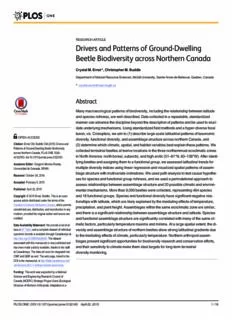
Drivers and Patterns of Ground-Dwelling Beetle Biodiversity across Northern Canada PDF
Preview Drivers and Patterns of Ground-Dwelling Beetle Biodiversity across Northern Canada
RESEARCHARTICLE Drivers and Patterns of Ground-Dwelling Beetle Biodiversity across Northern Canada CrystalM.Ernst*,ChristopherM.Buddle DepartmentofNaturalResourceSciences,McGillUniversity,Sainte-Anne-de-Bellevue,Quebec,Canada * [email protected] Abstract Manymacroecologicalpatternsofbiodiversity,includingtherelationshipbetweenlatitude andspeciesrichness,arewell-described.Datacollectedinarepeatable,standardized mannercanadvancethedisciplinebeyondthedescriptionofpatternsandbeusedtoeluci- dateunderlyingmechanisms.Usingstandardizedfieldmethodsandahyper-diversefocal taxon,viz.Coleoptera,weaimto(1)describelarge-scalelatitudinalpatternsoftaxonomic OPENACCESS diversity,functionaldiversity,andassemblagestructureacrossnorthernCanada,and Citation:ErnstCM,BuddleCM(2015)Driversand (2)determinewhichclimatic,spatial,andhabitatvariablesbestexplainthesepatterns.We PatternsofGround-DwellingBeetleBiodiversity collectedterrestrialbeetlesattwelvelocationsinthethreenorthernmostecoclimaticzones acrossNorthernCanada.PLoSONE10(4): e0122163.doi:10.1371/journal.pone.0122163 inNorthAmerica:northboreal,subarctic,andhigharctic(51–81°N,60–138°W).Afteridenti- fyingbeetlesandassigningthemtoafunctionalgroup,weassessedlatitudinaltrendsfor AcademicEditor:GregorioMoreno-Rueda, UniversidaddeGranada,SPAIN multiplediversityindicesusinglinearregressionandvisualizedspatialpatternsofassem- blagestructurewithmultivariateordinations.Weusedpathanalysistotestcausalhypothe- Received:October24,2014 sesforspeciesandfunctionalgrouprichness,andweusedapermutationalapproachto Accepted:February5,2015 assessrelationshipsbetweenassemblagestructureand20possibleclimaticandenviron- Published:April22,2015 mentalmechanisms.Morethan9,000beetleswerecollected,representing464species Copyright:©2015Ernst,Buddle.Thisisanopen and18functionalgroups.Speciesandfunctionaldiversityhavesignificantnegativerela- accessarticledistributedunderthetermsofthe tionshipswithlatitude,whicharelikelyexplainedbythemediatingeffectsoftemperature, CreativeCommonsAttributionLicense,whichpermits precipitation,andplantheight.Assemblageswithinthesameecoclimaticzonearesimilar, unrestricteduse,distribution,andreproductioninany medium,providedtheoriginalauthorandsourceare andthereisasignificantrelationshipbetweenassemblagestructureandlatitude.Species credited. andfunctionalassemblagestructurearesignificantlycorrelatedwithmanyofthesamecli- DataAvailabilityStatement:Weprovidealistofall maticfactors,particularlytemperaturemaximaandminima.Atalargespatialextent,thedi- taxainS1Table,andacompletedatasetofindividual versityandassemblagestructureofnorthernbeetlesshowstronglatitudinalgradientsdue specimenrecordsisavailablethroughCanadensysat tothemediatingeffectsofclimate,particularlytemperature.Northernarthropodassem- http://doi.org/10.5886/5dvj8642.Thedataset blagespresentsignificantopportunitiesforbiodiversityresearchandconservationefforts, associatedwiththismanuscriptisnowpublishedand hasbeenmadepubliclyavailable,thankstothestaff andtheirsensitivitytoclimatemakethemidealtargetsforlong-termterrestrial atCanadensys.Thedatawillsoonbeintegratedinto diversitymonitoring. CBIFandGBIFaswell.Thewebpage,linkedtothe DOIinthemanuscript,ishttp://data.canadensys.net/ ipt/resource.do?r=northern-beetle-specimens. Funding:ThisworkwassupportedbyaNational ScienceandEngineeringResearchCouncilof Canada(NCERC)StrategicProjectGrant(Ecological StructureofNorthernArthropods:Adaptationtoa PLOSONE|DOI:10.1371/journal.pone.0122163 April22,2015 1/16 BiodiversityofNorthernBeetles ChangingEnvironment)awardedtoC.Buddle,T. Introduction Wheeler,andD.Currie(UniversityofToronto),its Macroecologistshavesuccessfullydescribedlarge-scalespatialpatternsofbiodiversityandspe- supportingpartnersandcollaborators,andaNSERC CGS-DAlexanderGrahamBellCanadaGraduate ciesdistributions.Amongthem,thelatitudinalgradientofspeciesrichness,inwhichfewerspe- ScholarshipawardedtoC.Ernst.Thefundershadno ciesarefoundathighlatitudescomparedtoattheequator,hascaptivatedresearchersformany roleinstudydesign,datacollectionandanalysis, decades[1].Overthepastdecade,therehasbeenincreasedinterestinelucidatingthecausal decisiontopublish,orpreparationofthemanuscript. mechanismsbehindlatitudinaldiversitypatterns[2–5].Thesearchforlikelymechanismshas CompetingInterests:Theauthorshavedeclared beenchallenging,however,andalthoughabroadrangeofclimatic,evolutionary,biotic,and thatnocompetinginterestsexist. spatialhypotheseshavebeenputforth,reviewedby[3],nosinglefactorhasbeenidentifiedasa keymechanism.Itishighlylikelythatthenumberofspeciesfoundatdifferentlatitudes,and thewaythesespeciesassembleoverspaceandtime,istheresultofmultipleinteractingecologi- calandevolutionaryfactors[6,7].Despitethechallengeofteasingaparttherelativecontribu- tionsofdifferentfactorstopatternsofdiversity,climate—inparticular,temperature—hasbeen broadlyrecognizedasakeyelementinbothterrestrialandaquaticsystems[8–10]andisworthy ofadditionaltesting. Recently,someworkershavebegunincludingalternativeorcomplimentarygenetic,mor- phologicalorfunctionalmeasuresofdiversityalongsidethetraditionaltaxonomicmetricof speciesrichness[11].Functionmayplayaparticularlyimportantroleininfluencingspeciesdi- versitypatterns,asspeciesrichnessmaybelimitedbybioticinteractions,differencesinlifehis- torytraits,andenvironmentalgradientsthatinfluencenicheavailability[12].Theinclusionof functionaldiversityinmacroecologicalstudiesmayultimatelyyieldstrongertestsofbiodiversi- tytheories[5,12,13]. Inadditiontoexpandingthelensthroughwhichweexaminediversitypatternsbeyondtax- onomy,wecanalsousetheframeworkestablishedbyearliermacroecologicalstudiesasaplat- formfromwhichtobroadenthescopeoffuturework.Someauthorshaveidentifiedavenuesof researchthatholdgreatpromisefortheadvancementofmacroecologicaltheory,namely,the inclusionof:(1)standardized,repeatablefaunalsampling,(2)broadertaxonomicorfunctional scopes,(3)broaderecologicalscopes(e.g.,multiplehabitatsorbiomes),and/or(4)underrepre- sentedyetecologicallysignificantbiomes(aquaticsystemsandpolarregions)andtaxa(inver- tebrates,non-vascularplantsandfungi)[3,5].Whilesomeoftheseadvancementspresent logisticalchallenges,workingtoovercomethemmaygeneratesufficientquantitativedatato testandsupportgeneralizablestatementsaboutlarge-scalepatternsandprocessesofdiversity [14,15].Understandingtheunderlyingprocessesresponsibleforpatternsofdiversitywillpro- videpowerfulmechanismsforpredictingtheeffectsofclimatechangeandotheranthropogenic disturbancesonbioticcommunitiesandtheircomponentspecies[5]. Testinglarge-scalebiodiversitypatternsandprocessesrequiresusingafocaltaxonthatisdi- verse,easilysampled,representativeofdifferentprocessesandfunctions,taxonomicallywell understood,andsensitivetoenvironmentalorecologicalchanges[16].Beetlesareanideal studytaxon:theyareoneofthemosttaxonomicallyandfunctionallydiversegroupsofanimals [17],andarethemostabundant,diverseandecologicallysignificantepigeic(i.e.,livingpre- dominantlyonthegroundsurface)insecttaxoninnorthernsystems[18,19].Beetlesarealso easilycaughtusingpassivetrappingmethodsthatcanbestandardizedandthuspermitcom- parisonsofassemblagesacrosstimeandspace[20–22],andshowrapidresponsestoenviron- mentalchange[23–25].Thesefactorsmakenorthernbeetlesidealfocaltaxaforconductinga comprehensiveexaminationofterrestrialdiversityandassemblagestructure. Theoverallobjectiveofourresearchwastoconductastandardized,species-levelassess- mentofbothtaxonomicandfunctionalbiodiversitypatternsacrossmultiplebiomes,using beetlesasafocaltaxon.Ourspecificgoalswereto:(1)quantifylatitudinalpatternsindiversity andassemblagestructure(taxonomicandfunctional),and(2)establishtheclimaticand/or PLOSONE|DOI:10.1371/journal.pone.0122163 April22,2015 2/16 BiodiversityofNorthernBeetles environmentalfactorsassociatedwithtaxonomicand/orfunctionalassemblagestructure acrossalargegeographicextent,whichwastwelvelocationsinthethreenorthernmostecocli- maticzonesofNorthAmerica(Table1).Wehypothesizedthat:(1)beetleswillconformto classicallatitudinalgradientsofdiversity,withgreaterspeciesandfunctionalrichnessatlower latitudes;(2)speciesrichnessisdirectlyinfluencedbyclimaticvariables,whichareinfluenced bylatitude;(3)speciesandfunctionalassemblagestructureswilldisplaylatitudinalgradients ofsimilarity;(4)variationsinassemblagestructurewillbebestexplainedbyclimatic,rather thanspatialorbiotic,variables. MaterialsandMethods Studyregionandsamplinglocations In2010and2011,aspartofalargerresearchproject[26,27]wecollectedterrestrialbeetlesat twelvelocationsinthethreenorthernmostecoclimaticregionsofnorthernCanada[28]:four locationswereinthenorthborealregion,fourinthesubarcticandfourinthehigharctic (Table1).Theextentofthestudyconsistsofalatitudinalgradientof51–81°Nandalongitudi- nalgradientof60–138°W.Permitsweregrantedbythefollowingagenciestoconductsampling inthenorthernterritories:NunavutResearchInstitute(ScientificResearchLicence),Nunavut DepartmentoftheEnvironment(WildifeResearchPermit),Yukon’sDepartmentofTourism andCulture(ScientistsandExplorersLicence),AuroraResearchInstituteoftheNorthwest Territories(ScientificResearchLicence),ParksCanadaAgency(ResearchandCollectionPer- mit;fortheLakeHazenlocation,whichfallsintheQuttinirpaaqNationalParkofCanada, NU).Innoinstancedidourworkinvolvethecollectionendangeredorprotectedspecies.In lightofthisfact,andsincenoothersamplingwasconductedinprovincialparksorwildlifere- serves,nospecificpermitswererequiredtosampleonpubliclandintheotherlocations. Ateachlocation,weestablishedthreereplicateswithinabout15kmofeachother.Incon- siderationofthefactthathabitatselectionbynorthernarthropodsishighlydependenton moistureandvegetation[29,30],eachreplicatecontainedtwobroadlydelimitedandecolog- icallydistincthabitats.“Mesic”habitatsarecharacterizedbyhigherelevationsandwell-drained soil,while“wet”habitatshavesaturatedorpoorlydrainedsoils,andcanbefoundinadjacent low-lyingregions.Themesicvegetationwasadiscontinuouscoverofdwarfshrubs,perennial forbs,andlichens.Wethabitatscontainedcontinuouscoverofmoss,sphagnum,saxifrages Table1. Names,coordinates,andecoclimaticzonesofsamplinglocations,anddatesofsampling. SamplingLocation Latitude,Longitude EcoclimaticZone SamplingPeriods(dates) SamplingYear 1 2 3 LakeHazen,NU 81.82975,-71.32244 HighArctic 19–23.vii 23–28.vii - 2010 BanksIsland,NWT 73.22412,-119.55255 HighArctic 7–11.vii 11–15.vii 15–19.vii 2011 CambridgeBay,NU 69.12177,-105.41688 HighArctic 7–11.vii 11–15.vii 15–19.vii 2011 Iqaluit,NU 63.76144,-68.57352 HighArctic 17–21.vii 21–25.vii 25–29.vii 2010 Kugluktuk,NU 67.78157,-115.27824 Subarctic 22–26.vi 26–29.vi 29.vi-2.vii 2011 TombstoneMtns.,YT 64.60629,-138.35637 NorthBoreal 21–24.vi 24–27.vi 27.vi-01.vii 2011 Churchill,MB 58.73573,-93.79789 Subarctic 1–5.vii 5–9.vii 9–13.vii 2010 Schefferville,QC 54.75970,-66.71120 Subarctic 30.vi-3.vii 3–6.vii 6–9.vii 2010 NormanWells,NWT 65.29112,-126.62262 Subarctic 7–11.vi 11–14.vi 14–17.vi 2011 Yellowknife,NWT 62.52110,-113.38174 NorthBoreal 7–11.vi 11–15.vi 15–18.vi 2011 GooseBay,NFLD 53.21199,-60.45062 NorthBoreal 15–18.vi 18–21.vi 21–24.vi 2010 Moosonee,ON 51.28034,-80.64252 NorthBoreal 15–19.vi 19–23.vi 23–25.vi 2010 doi:10.1371/journal.pone.0122163.t001 PLOSONE|DOI:10.1371/journal.pone.0122163 April22,2015 3/16 BiodiversityofNorthernBeetles andsedges.Inordertoensureconsistencyofsamplinginbothhabitatsacrossalllocations,we establishedallreplicatesinopenareaswithnotreecanopycover;weencounteredsomedwarf blackspruceinsomeofthemoresouthernsites. Insectsamplingandspecimenprocessing Inallreplicatedhabitatsateachlocation,wesetninepitfallandnineyellowpantrapsinthree transectsasa30x75mgrid.Wedeployed108trapsperlocation,and1296trapsintheentire samplingdesignandweservicedthemthreetimesovertwoweeks(seeTable1forcollection dates,andforacompletedescriptionoftrappingandcollectionprotocols,see[26]).Toaccount forphenology,wesampledthesouthernmostlocationsfirst,andthenorthernmostlast,sothat insectactivitywouldbeapproximatelyequalatalllocations.Weplacedspecimensin95%etha- nolandreturnedthemtothelaboratoryforsorting,andidentifiedadultbeetlestospeciesor morphospeciesusingtraditionalmorphologicalapproaches. Weassignedeachbeetletoafunctionalgroupbasedonitspredominantfoodsourceand modeoffeeding[14].Sincebiomassintegratesfunctionalcharacteristicsofassemblagessuch asenergyandnutrientflow(Saint-Germainetal.2007;Wangetal.2009),weuseditasthe metrictodescribeassemblagesfunctionally(i.e.,ratherthanabundance).Weestimatedthe biomassofeachbeetleusinglength:biomassregressions[31,32],usingmeasuredbodylength oraknownaveragelengthofcommonspeciescollectedpreviously[26]. Voucherspecimensofallspeciesarenowcontainedinatleastoneofthefollowingcollec- tions:LymanEntomologicalMuseum(Sainte-Anne-de-Bellevue,Québec,Canada),Canadian NationalCollectionofInsects,ArachnidsandNematodes(Ottawa,Ontario,Canada),Canadi- anMuseumofNature(Ottawa,Ontario,Canada). Environmentalvariables Wequantitativelyassessedtheplantcommunityateachlocationbyrandomlyestablishingfive 1m2quadratsinandadjacenttothetrapgridineachhabitatreplicate.Tocharacterizetheveg- etationineachquadratweuseda%coverclassificationsystem,theBraun-Blanquetscale[33]. Weassignedplantstoaclass(forbs,shrubs,graminoids,mosses,lichens),gaveeachclassa Braun-Blanquetscoreof1to6,anddeterminedthemeanscoreforeachclassforeachlocation. Wemeasuredthemaximumheightofthevegetationofanyclass(MaxVegHt)ineachquadrat, anddeterminedanaverageoftheseheightsforeachlocation. Climatedataareavailableonline(CanadianNationalClimateDataandInformationAr- chive(http://climate.weatheroffice.gc.ca).Weusedclimatenormals(calculatedusingatleast 15yearsofdatatakenbetween1981–2010)recordedattheweatherstationclosesttoeachloca- tiontoobtainthefollowing:meanannualtemperature(MeanTemp),meanmaximumtemper- ature(MaxTemp),meanminimumtemperature(MinTemp),meantemperatureofwarmest month(WarmMean),meantemperatureofcoldestmonth(ColdMean),meantotalannual precipitation(TotPrecip),meandegreedaysabovezero(DDA0),meandegreedaysbelowzero (DDB0),meanwindspeed(Wind),meanannualdayswithsunshine(SunDays),meanannual totalsunshinehours(SunHrs),andnumberoffrost-freedays(Frost).Giventheirproximity, weconsideredallreplicatesatthesamelocationtohavethesameclimateconditions. Dataanalyses WeconductedallanalysesusingR,version3.1.1(RCoreTeam,2014).Wedescribedthetotal abundanceofbeetlesateachlocation.Whileoursamplingwasstandardized,theresultingsam- plesizeswereunequalandthereweremanyrarespecies.Therefore,inadditiontocalculating theobservedspeciesrichness,observedfunctionalgrouprichness,Simpson’sdiversity,and PLOSONE|DOI:10.1371/journal.pone.0122163 April22,2015 4/16 BiodiversityofNorthernBeetles Pielou’sevenness,wealsousedtheChao1index[34],anasymptoticestimator,togenerateun- biasedestimatesofexpectedspeciesrichnessateachlocation.Theanalyseswereperformed usingtheveganpackage[35]. Totestwhetherbeetleswouldconformtopredictedlatitudinalgradientsofdiversity,we usedlinearregressionstotesttherelationshipbetweeneachdiversityindexandlatitude.The indiceswerelog-transformedpriortorunningthemodelstoensuredatametassumptionsof normality.Weremovedextremeoutlierstoimprovemodelfit:IQAforobservedspeciesrich- ness,Chao1andfunctionalrichness,andNORforevennessandSimpson’sindex. Inadditiontoidentifyinglatitudinaldiversitypatterns,wewantedtodetermineiflatitude hasanindirecteffectondiversitythatismediatedbyotherbiotic,climaticorspatialfactors. Confirmatorypathanalysisisonemethodoftestingmultivariatecausalhypothesesthatcannot betestedthroughrandomizedexperiments[36].WeusedShipley’sd-separationtestofcausal hypotheses[36,37]toanalysetherelationshipsbetweenlatitude,diversity,andmechanistic factors.Inthisanalysis,thecausalhypothesesarerepresentedbyasetofstructuralequations thatarevisualizedasapathmodel(ordirectedacyclicgraph;DAG),andthesecausalrelation- shipsimplyindependencerelationsbetweenotherpairsofvariables(abasisset),eitherdirectly orafterconditioningonothervariables.Usingthepackageggm[38]wedevelopedthreealter- nativeDAGswithhypothesisedrelationshipsbetweenlatitude,speciesandfunctionaldiversity, andseveralmechanisticvariables,thengeneratedthebasissetsoftheconditionalindependen- ciesresultingfromthemodels. Theinitiallistofmechanismsconsideredincludedtheclimateandvegetationvariablesde- scribedintheprevioussection.Inordertoavoidissuesassociatedwithautocorrelationandto achievethemostparsimoniousDAG,wereducedthenumberofvariablesinthemodelbycon- sideringthestatisticalandecologicalrelationshipsbetweenthevariables.Firstwevisualized thedatawithscatterplotsofallpairwisecombinationsofvariables.Alltemperatureandsun- relatedvariableswerecorrelated,soMeanTempwasselectedasaproxyforalltemperature measures.ThereweresomemissingWindvaluessothisvariablewasomitted.Precipitation wasmoderatelycorrelatedwithMeanTemp,butsinceitcapturesaverydifferentcomponentof climate,andbecausemoisturecanbeaconstraintfornorthernarthropods[18,30],itwasre- tained.AllvegetationclassBraun-Blanquetscoreswereretained,aswasMaxVegHt.Next,we examinedthevarianceinflationfactorsusingtheviffunctionintheHHpackage[39].Somein- flationfactorswerehighduetorelationshipsbetweendifferentvegetationclasses,suggesting weshouldselectonerepresentativevegetationvariable.Weadditionallyperformedstepwise AICmodelselection,whichselectedMeanTemp,MaxVegHtandTotPrecipasindependent variables.Thesestepsandresultsledustoconcludetheselectionwiththesethreeecologically significant,noncolinear(VIFbetween2.2and3.5)variables. Weconsideredthreeplausiblealternativemodelstotesttherelationshipbetweenlatitude andspeicesrichness(Fig1A–1C).Theseincludedthesimplestmodel(Fig1A),whereonlylati- tudeactsonthemediatingeffects,andtwomodelswhereinteractionsbetweenmediatingfac- torswereconsidered.InmodelB,temperature(T)isdirectlyinfluencedbylatitude,whichin turnaffectsplantheightandprecipitation.InmodelC,precipitationadditionallyinfluences vegetationheight.ForeachDAG,wetestedallhypothesizedindependencesbetweenthesevari- ablesandthenconductedoveralltestsofthemodelsusingFisher’sCtests.Weperformeda separatepathanalysisforfunctionalgrouprichness.Again,wedevelopedthreeplausiblemod- els,usingthebest-fitDAGforspeciesrichnessasastartingpoint(Fig1,Model1),becauseit suggestedthatinteractionsbetweentemperature,vegetationandprecipitationwerenotimpor- tant.Sincefunctionalgrouprichnessislikelytoincreaseasmorespeciesareadded(asshown earlier,thereisapositiverelationshipbetweenspeciesandfunctionalrichness),weincluded speciesrichnessinthemodel.Thethreemodelswedevelopedweredesignedtodetermine PLOSONE|DOI:10.1371/journal.pone.0122163 April22,2015 5/16 BiodiversityofNorthernBeetles Fig1.Mapofthe12studylocations(NorthPoleAzimuthalprojection),showingthespatial distributionoffunctionalgroups.FGswerepooledintotrophicgroups,andthepiechartsshowthe proportionofthetotalsitebiomassrepresentedbyeachtrophicgroup:carnivore(black),herbivore(white), omnivore(grey)anddetritivore(diagonallines).Piechartsizesaregraduatedaccordingtotheproportionof theentirestudy’sbeetlescollectedatthatsite.Higharcticsites:HAZ(LakeHazen,NU);BAN(BanksIsland, NWT);CAM(CambridgeBay,NU);IQA(Iqaluit,NU).Subarcticsites:KUG(Kugluktuk,NU);TOM (TombstoneMtns.,YT);CHU(Churchill,MB);SCH(Schefferville,QC).Northborealsites:NOR(Norman Wells,NWT);YEL(Yellowknife,NWT);GOB(GooseBay,NFLD);MOO(Moosonee,ON). doi:10.1371/journal.pone.0122163.g001 whether:a)latitudeactsdirectlyonfunctionalrichness,b)theeffectsoflatitudearemediated byspatialorbioticvariables,and/orc)speciesrichnessprovidesasecondlevelofmediation (i.e.,thattheeffectsoftemperature,vegetationandprecipitationonfunctionalrichnessare solelyoradditionallymediatedbyspeciesrichness). Wehypothesizedthatassemblageswoulddemonstratespatial(latitudinal)gradientsofsim- ilarity.Totestthis,wevisualizedspeciesandfunctionalassemblagesateachlocationwithnon- metricmultidimensionalscaling(NMDS)ordinations,usingtherich[40]andvegan[35]pack- ages.Non-metricmultidimensionalscalingisanindirectordinationapproachthatmaximizes therankordercorrelationbetweendistancesinadistancematrix,andthefunctionweused (metamds)usesmultiplerandomstartingconfigurationstofindastableglobalsolutionforthe ordination.Assemblagesthataremoresimilartoeachotherarearrangedmorecloselyinthe ordinationspace.Inthiscase,wegeneratedtheordinationsusingBray-Curtisdistancematri- cesoflog+1transformedabundances(species)orbiomasses(functionalgroups).Becausethe speciesassemblagesatHAZwerecomposedofonlyasinglespecies,weomittedthelocation fromtheNMDSanalyses.Wewerealsointerestedintherelationshipbetweenspeciesand functionalassemblages,sowecomparedthecongruenceofthetwoordinationsusingProcrus- tesrotationanalysis,andassessedthecorrelationbetweenthenusingapermutationalstatistic calculatedbythefunctionprotest[41]. Totesttherelationshipsbetweenassemblagestructureandspatial,climaticandbioticfac- tors,theenvfitfunctionintheveganpackagewasusedtofiteachfactorontheordinationsas PLOSONE|DOI:10.1371/journal.pone.0122163 April22,2015 6/16 BiodiversityofNorthernBeetles vectors.Thedirectionofeachvectorindicatesthedirectioninwhichthelinearchangeinthe variableisthefastest,andthelengthofthevectorisproportionaltothestrengthofthecorrela- tionbetweenthevariableandthepositionoftheassemblagesinordinationspace.Thisfunc- tionprovidesanobjectiveinterpretationoftheresultsofunconstrainedordinationanalyses andgeneratesameasureoffitaswellasasignificancevaluebasedonapermutationtest(1000 permutations). Results Wecollected9062beetles:2832inthehigharctic,3275inthesubarcticand2955inthenorth borealzone.Abundancesvariedbetweenlocations,rangingfrom14individualscollectedfrom thenorthernmostlocation(LakeHazen,NU),to1696individualsfromCambridgeBay,NU, alsointhehigharctic(Fig1).Therewasnorelationshipbetweenlatitudeandabundance.Thir- ty-fourfamiliesand155generawererepresentedinthecollection.Over80%ofthecollection wascomprisedofthreefamilies:Carabidae(6221individuals,68.8%oftotalnumberofspeci- mens),Staphylinidae(870,9.6%),andCryptophagidae(247,2.7%).Wefoundstaphylinidsat alllocations,carabidsatalllocationswiththeexceptionofLakeHazen,andcryptophagids onlyfromlocationsinthesubarcticandborealzones.WeprovidealistofalltaxainS1Table, andacompletedatasetofindividualspecimenrecordsisavailableathttp://doi.org/10.5886/ 5dvj8642. Species-levelidentificationsweredonewheneverpossible,thoughwefocusedourefforts onidentifyingthemostabundantandwidespreadtaxa(e.g.,Carabidae,Staphylinidae)and thosethataretaxonomicallywellknown.Intotal,weidentified464speciesandmorphospe- cies,andrichnessrangedfromasinglespeciesobservedinLakeHazen,to115inthenorthbo- reallocationMoosonee,ON.Amongthesampleswere15newprovincialand/orterritorial (cid:1) records(denotedbyanasterisk, ,nexttothespeciesnameinS1Table).Mostspecieswere foundatthreeorfewerlocations,butothersweremorewidespread.Forexample,inthehigh andsubarcticzones,Pterostichushaematopus,P.brevicornis,P.caribouandAmaraalpina wereparticularlyabundantandwidelydistributed;together,thesefourspeciesrepresented 44.0%ofthetotalcatch. Eighteenfunctionalgroupswereidentified,representingdiversespecialistandgeneralisther- bivoresandcarnivores,omnivores,andsaprophages,withdifferentfoodsourcesandmodesof feeding(S2Table).Functionalgrouprichnessrangedfrom1inLakeHazento13groupsintwo ofthesubarcticlocations(NormanWellsandYellowknife,NWT)andoneboreallocation, Moosonee.CarnivorescomprisedthemajorityofthebiomassinallsitesexceptGooseBay, NFLD,whichwastheonlylocationwhereherbivoreshadthegreatestproportionofbiomass (Fig1).Strictherbivoreswerelargelyabsentfromthesubarcticandhigharcticlocations,but werewellrepresentedintheborealsites.AlthoughMoosoneehadveryhighspeciesandfunc- tionalrichness,highnumbersoftwoverylargepredaciouscarabidbeetleswerecaught(Cara- busmaeanderandC.melanarius),andthesedominatedtheoverallbiomass(Fig1).Omnivores wereexceptionallyprominentinthehigharctic,representedprimarilybytheopportunistically predaciousgranivore,Amaraalpina(Fig1). Diversity Bothobservedspeciesrichness(P=0.002,R2=0.6345,F=18.36,df=9)andexpectedspecies richness(P=0.002,R2=0.6411,F=18.86,df=9)exhibitedstrongnegativerelationships withlatitude.TheSimpson’sindexsimilarlydeclinedsignificantlywithlatitude(P=0.0043, R2=0.5723,F=14.38,df=9),butevennesshadnosignificantspatialpattern(P=0.06, R2=0.3078,F=5.002,df=8).Functionalgrouprichnesshadahighlysignificantnegative PLOSONE|DOI:10.1371/journal.pone.0122163 April22,2015 7/16 BiodiversityofNorthernBeetles relationshipswithlatitude(P=0.0007,R2=0.7101,F=25.49,df=9).Functionalgroup richnessandspeciesrichnesshaveaverystrongpositivelinearrelationship(P<0.0001, R2=0.9307,F=148.6,df=10). Inourpathanalysisofspeciesdiversity,weoptedtoincludeMeanTemp,TotPrecip,and MaxVegHt,asmediatingeffects.Fisher’sCtests(whichsimultaneouslytestallindependencies inaDAG)indicatedthat,whileallthreemodelsweregoodfitswithnoimportantdependencies missing,thefirstandsimplestmodel(Fig2A)providedthebestoutcome(Fishers’sC=3.637, P=0.888).Thepathanalysisindicatesthatspeciesrichnessisindirectlyaffectedbylatitude. MeanTemp,MaxVegHtandTotPrecipalldeclineaslatitudeincreases.MeanTempandMax- VegHthavepositiveeffectonspeciesrichness,whileTotPreciphasanegativeeffect.The strengthanddirectionoftherelationshipsdeterminedbythepathanalysisforthebest-fit modelareshowninFig2(Model1).Forfunctionaldiversity,Fisher’sCtestsindicatedthatall threemodels(D-F)wereacceptable,butmodelFwasthebestfit(Fisher’sC=5.099,P=0.984). InthispathanalysiswefoundthatMeanTempandspeciesrichnessbothhadapositiveeffect onfunctionalrichness,andthatlatitudehadanindirectnegativeeffectthroughthesemediating factors(Fig2,Model2).Relationshipsbetweenfunctionalgrouprichness,andMaxVegHtand TotPrecip,didnotimprovethemodel. Fig2.Threealternative(A,B,andC)directedacyclicgraphs(DAG)ofhypothesizeddirectandindirecteffectsonspeciesrichness(S).Model1: resultsofbestfitpathmodel(derivedfrommodelA).D,EandFarealternativeDAGsofhypothesizedeffectsonfunctionalgrouprichness(F).Model:results ofthebestfitpathmodel(frommodelF).Thedirectionofthearrowindicatesthedirectionoftherelationship.Solidlinesindicateasignificantrelationship. EstimatedcoefficientsandP-valuesareshownforeachrelationship.Latitude(L),TotPrecip(P),MeanTemp(T)andMaxVegHt(V) doi:10.1371/journal.pone.0122163.g002 PLOSONE|DOI:10.1371/journal.pone.0122163 April22,2015 8/16 BiodiversityofNorthernBeetles Assemblagestructure SolutionswerereachedfortheNMDSordinationsofthespeciesassemblages(stress=0.079913, Fig3a)andthefunctionalassemblages(stress=0.05501,Fig3b).WiththeexceptionofCAM andBAN,whosespeciesassemblagesessentiallyoverlapintheordinationspace,alllocations displayeddistinctspeciesandfunctionalassemblages.Thearrangementofthelocationsinthe ordinationsindicatedthatthoseinthesameecoclimaticzonehadsimilarassemblages,and thattherewerecleardelimitationsbetweenzones.Functionalassemblagesfromthewestern andeasternpartofthecontinentshowaslighttendencytoassembleclosertogether,evenbe- tweenecoclimaticzones;thisismorepronouncedforlocationsinthenorthborealandsubarc- tic.Agradientofsimilaritywasevidentbetweenecoclimaticzones:assemblagesinthe Fig3.Non-metricmultidimensionalscalingordinationsshowingsimilaritiesbetweena)species,and b)functionalassemblagesfromateachlocation.Shadedpolygonsareusedtodelimittheordination spaceoccupiedbysitescontainedwithinthesameecoclimaticzone.Spatial,climatic,andbioticvariables thataresignificantlycorrelatedwiththeassemblagesareplottedontheordinationspaceasvectors(for clarity,non-significantvariablesareomitted,andonlythemostimportanttemperature-relatedvariableis includedforeachordination);thelengthofthevectorindicatesthestrengthofthecorrelation.(HAZhasbeen omittedasanoutlerfrombothordinations,asitcontainsonlyone,uncommonspecies). doi:10.1371/journal.pone.0122163.g003 PLOSONE|DOI:10.1371/journal.pone.0122163 April22,2015 9/16 BiodiversityofNorthernBeetles subarcticweremorelikethosefoundinthehigharctic,whilenorthborealassemblageswere moresimilartosubarcticthantohigharcticassemblages.Speciesassemblagestructurewassig- nificantlycorrelatedwithlatitude(S3Table).AccordingtotheProcrustesrotationanalysis,the speciesandfunctionalordinationswerecorrelated(Procrustessumofsquares=0.36157,Pro- crustescorrelation,r=0.7964,P=0.001,999permutations). Speciesandfunctionalassemblagestructureweresignificantlycorrelatedwithalltempera- ture-drivenclimaticfactors,withtheexceptionthatfunctionalassemblageswerenotrelatedto DDBO(S3Table).BothassemblagetypeswerealsosignificantlyrelatedtoFrost.Speciesas- semblagestructurewasadditionallysignificantlyrelatedtoTotPrecip,whilefunctionalassem- blagealsohassignificantrelationshipswithSoilD,VarSoilDandGramCov.Otherwise,the plantcommunitycompositionisnotrelatedtoeitherspeciesorfunctionalassemblagestruc- ture.Variablesthataresignificantlyrelatedtoassemblagestructureareplottedasvectorsin Fig3(onlythetemperaturefactorwiththestrongestrelationshiptoassemblagestructureis shown,forclarity). Discussion Atalargespatialextent,thediversityandassemblagestructureofnorthernbeetlesshowstrong latitudinalgradients,primarilyduetomediatingeffectsofclimate,particularlytemperature. Ourresearchspannedalatitudinalgradientof30°,includedthreeecoclimaticzones,andused standardizedfieldsamplingofterrestrialbeetlestouncoverbiodiversitypatternsacrossalarge geographicextent.Macroecologicalstudieswithextentsthatrangelessthan20°oflatitudeare unlikelytoshowclearspatialpatternsofspeciesrichness,evenifsuchpatternsexist[3];our findingsshouldthereforeprovideanaccurateportrayalofspatialbiodiversitypatternsinthe farnorth.Wefoundthatbeetlespeciesrichness(observed,predicted,andasmeasuredbythe Simpson’sindex)exhibitsclassicalnegativerelationshipswithlatitude.Thisalignswithgeneral observationsofbeetlerichnessdrawnfrompresence/absencedatainarcticandnorthernboreal regions[19]andwithsimilarpatternsdescribedforotherinsecttaxaatacontinentalscalein temperateregions,includingantsinEurope,andgrasshoppers,butterfliesanddungbeetlesin NorthAmerica[3]. Evennessshowedatendencytodeclinewithincreasinglatitude,butthegradientwasnon- significant.Speciesrichnessandevennesscanbe,andoftenare,similaralonglatitudinalgradi- ents,buttheymayalsoshownoorevennegativerelationshipswitheachother,astheymayre- flectdifferentaspectsofspatialvariationinspeciesassemblagesanddifferentresponsesto ecologicalfactors[42,43].Alternatively,ifassemblagesaremorespecies-richbecausetheypos- sessgreaternumbersofrarespecies,thenwemightexpectlatitudinaldecreasesinrichnessto beaccompaniedbygreaterevenness[3].Whilethemajorityofourrarespecies(singletonsand doubletons)wereindeedlocatedinthemoresoutherlylocations,thisdidnottranslatetoapos- itivelatitudinalevennesstrend. Inourstudy,functionalgrouprichnessshowedaverystrongclassicalspatialgradient,de- creasingsharplywithincreasinglatitude.Studiesonlarge-scalelatitudinalpatternsofanimal functionaldiversityarescarceandtheirconclusionsarevariable.Stevensetal.[14],forexam- ple,foundthatNewWorldbatfunctionaldiversity,richnessanddominancestronglyincreased towardstheequator,andmammalianfunctionaldiversitygenerallyappearstodisplaythe samepattern[15].Conversely,ananalysisofinvertebratescollectedfrom1000streammoni- toringstationsintheUSshowedthatfunctionalrichnessdecreasedonlyweaklywithincreased latitude[44]. Specificfunctionalgroupsorguildsmaydisplaydifferentlatitudinaldiversitypatterns.For example,alargesurveyofthefreshwaterdetriviorousshredderguildrevealedmuchhigher PLOSONE|DOI:10.1371/journal.pone.0122163 April22,2015 10/16
Description: